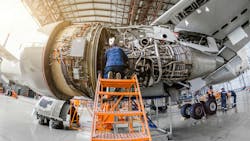Keeping Aircraft Airworthy: Finding the Balance Between Safety, Regulations and Expenses
Key Highlights
- Aircraft airworthiness depends on regular inspections, repairs, and adherence to strict safety and regulatory standards set by authorities like FAA, EASA, and CASA.
- Predictive maintenance using sensors and data analytics reduces costs and prevents unexpected failures, enhancing operational efficiency.
- Balancing safety, regulations, and costs requires strategic planning, technological adoption, and a proactive safety culture among all stakeholders.
Keeping aircraft airworthy is a crucial part of ensuring that flying remains one of the safest ways to travel.
However, keeping an airplane in top condition isn't just about conducting regular inspections or receiving a one-time certification. It involves carefully managing three major areas of aircraft maintenance: safety of maintenance procedures, adherence to aviation regulations and cost management.
How do you keep an aircraft airworthy?
According to the European Union Aviation Safety Agency (EASA), continued airworthiness is achieved by maintaining the condition of aircraft and aircraft components in compliance with aviation safety regulations. The Civil Aviation Safety Authority of Australia (CASA) also defines airworthiness as ensuring all systems and structures perform their intended function.
As these organizations assert, if an aircraft is declared airworthy at one point in time, that doesn’t mean it remains airworthy indefinitely. Planes need constant care through regular maintenance, repairs and adjustments according to rules set by aviation authorities like the Federal Aviation Administration (FAA). This process involves both planned checkups and unplanned repairs when problems arise.
How MROs and owners can improve aviation safety with thorough maintenance
When it comes to aviation and keeping aircraft airworthy, safety must come first. The Transportation Safety Board of Canada emphasizes that poor maintenance practices are among the leading causes of safety incidents. In addition, the UK Civil Aviation Authority (CAA) reports that lapses in maintenance were a contributing factor in 23% of reportable air safety occurrences.
Conducting insufficient maintenance or skipping steps in an aircraft’s maintenance protocol can lead to catastrophic accidents. A standout example is the 1988 Aloha Airlines Flight 243 incident, when a part of the plane's roof came off mid-flight because of hidden metal fatigue that stayed undetected.
MROs and aircraft owners can ensure the safety of all passengers and crew on a flight by following strict maintenance protocol that prioritize accurately determining airworthiness.
Shops should offer rigorous training for maintenance personnel so they’re able to examine aircraft meticulously, perform all maintenance tasks with precision and adjust protocol to new technologies and upgrades. Companies can also implement safety management systems (SMS) and quality assurance practices to prevent disasters.
What aviation regulations keep airplanes safe?
Every country has its own aviation authority, some examples being:
- Federal Aviation Administration (FAA) in the U.S.
- European Union Aviation Safety Agency (EASA) in Europe
- Civil Aviation Safety Authority (CASA) in Australia
- Civil Aviation Authority (CAA) in the UK
- Jordanian Civil Aviation Regulatory Commission (CARC) in Jordan
These agencies create rules and provide comprehensive regulatory frameworks to ensure aircraft safety, such as how often certain parts need to be checked or replaced. Operators must comply with various mandatory requirements, including ADs, Maintenance Review Boards (MRBs) and Continuing Airworthiness Management Expositions (CAMEs).
Failure to comply can result in penalties, grounding of aircraft or loss of air operator certificates. The International Civil Aviation Organization (ICAO) also provides global standards and practices to help align efforts internationally. Compliance is monitored through scheduled audits and through performance-based oversight mechanisms.
How to manage aircraft maintenance costs without compromising safety
Keeping airplanes in the air isn't cheap. There are often steep costs for replacement parts, labor, inspections and the time a plane spends on the ground.
However, smart planning can help reduce costs for organizations, especially those with large fleets they need to maintain. Some companies use advanced tools that predict problems before they happen, allowing them to perform repairs and preventative maintenance more efficiently and avoid unexpected delays.
Boeing stated that predictive maintenance, powered by sensors and data analytics, is becoming more common as a cost-effective solution. According to Airbus, adopting digital tools for maintenance has reduced operational disruptions by up to 30% for some operators, decreasing costs in turn.
How to balance safety, regulations and budget when keeping aircraft airworthy
One of the most common ways that organizations are finding the right balance to maintain aircraft effectively is the use of safety management systems (SMS). Creating a strong safety culture and adopting the right SMS helps organizations make responsible choices about how to best maintain their aircraft.
Research by the MIT International Center for Air Transportation highlights the long-term benefits of investing in safety management, showing reduced incident rates and improved operational efficiency. The U.S. Government Accountability Office (GAO) also emphasizes that consistent investment in preventive maintenance saves significantly on long-term repair and replacement costs.
Meanwhile, budget constraints can pressure operators to defer maintenance, risking safety and legal violations. For example, older aircraft usually need more repairs, sometimes requiring parts that are widely unavailable, which adds to overall expenses.
This makes decision-making in maintenance planning a strategic exercise, demanding both technical expertise and ethical accountability.
Keeping an aircraft airworthy is a continuous mission that involves more than just fixing what's broken; it is a multifaceted challenge that requires uncompromised safety protocol, strict adherence to regulatory standards and financial feasibility.
By using modern technology and working closely with aviation authorities, the industry can continue to keep flights safe, legal and cost-effective. Success in this endeavor relies on a proactive maintenance culture, investment in advanced technologies and a collaborative approach among regulators, manufacturers and operators.
About the Author

